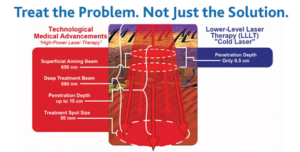Class IV-10 W Laser Therapy
Synergy has introduced Class IV-10 W Laser- therapy, a breakthrough treatment in pain management and treating chronic problems. Laser therapy is a drug-free, surgery-free technique to help make that goal a reality. Synergy uses the Laser, a Class IV high-powered therapeutic laser that can deliver up to 10 Watts (10,000 milliwatts). However the Laser power is adjustable from 500 milliwatts to 10 Watts allowing for a wide range of treatment protocols.
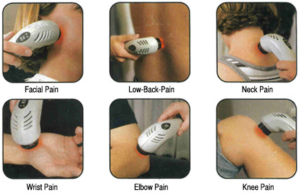
How Does Laser Works
Photons of laser light penetrate through the skin and are absorbed by special components in your body’s cells called chromophores. Just as photosynthesis creates energy for plants to grow, the absorption of the photons by your cells causes increased production of cellular energy. Another example in humans is vitamin D. Vitamin D is also synthesized via a photochemical process. Using laser light in areas of damage or injury means there is more available energy for accelerated healing. This is called biostimulation. Because of its biostimulatory nature, laser therapy has the potential to help almost any scenario whereby the body’s cells are not working to their optimum potential including muscle cells, bone cells and cartilage. Laser energy increases ATP production (cellular energy) and circulation which draws water, oxygen, and nutrients to the damaged area. This reduces inflammation, muscle spasms, stiffness, and pain. As the injured area returns to normal, function is restored and pain is relieved. These events lead to a cascade of beneficial effects and dramatic pain relief.
What benefits are provided to the patient through high power laser therapy?
Injuries treated with laser therapy heal faster
- Strengthening effect on tissue and bone repair
- Improved blood flow and lymphatic drainage
- Effective means of relief of many pain syndromes
- Improved immune response
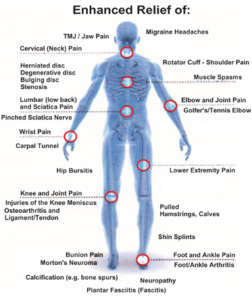
What health problems have researchers found to be improved by laser therapy?
- Soft Tissue Injuries
- Bone injuries
- Tedinopathies
- Back and Neck Pain
- Carpal Tunnel Syndrome
- Myofascial Trigger Points
- Epicondylitis (Tennis Elbow)
- Sprains, Strains
- Repetitive Stress Injuries
- Planter Fasciitis
- Neurogenic Pain
- RSD/CRPS
- Post-traumatic Injury
- Fibromyalgia
- Trigeminal Neuralgia
- Degenerative Joint Conditions
- Rheumatoid Arthritis
- Osteoarthritis
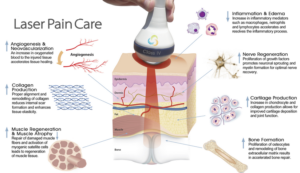
How many laser sessions are necessary and how long does a session take?
It depends on the condition. Sometimes once is enough, but sometimes five to ten sessions are needed to achieve a treatment goal. These sessions should be scheduled at two to three times per week for short duration treatment, or one to two treatments per week with longer treatment protocols. Each session will usually take about 20 minutes but it depends on the area that is being treated. For example a broken finger would take less time than hip pain simply because of the size of the area being treated.

How Laser Therapy helps in Avoiding Surgery?
HELP AVOID BACK SURGERY WITH LASER DISC THERAPY!
Back surgery is a serious decision for those who deal with chronic back and neck pain. Invasive and requiring extensive rehabilitation, back surgery should be a last resort when other alternative treatments fail to bring relief. Back surgery is not a guaranteed fix for what ails you, and many factors contribute to routine failure of back surgery to correct back problems. All too often, follow-up surgeries are required when back surgery fails to fix the unhealthy disc. When it comes to back surgery, seeking a second opinion evaluation before resorting to surgery might prove to be the smartest decision you have ever made.

SURGERIES OFTEN FAIL TO FIX THE PROBLEM!
There are many reasons why back surgeries are often unsuccessful or have disappointing results.
Often, surgeons are operating on muscles and vertebrae that have been injured or otherwise damaged. Scarring on the nerves, joints and tissue can lead to complications that are out of the surgeon’s hands. In some cases, spinal fusion surgeries, which lock up a portion of the spine, are successful in eliminating pain from an injury, but lead to future aches and pains in other areas
of the back because of the fusion surgery itself! The health of the patient can also influence the outcome of back surgery, and recent research indicates that smoking puts patients at high risk for unsuccessful back surgery.
Back surgery failure is so common that it has been termed Failed Back Surgery Syndrome, or FBSS. Statistics show that nearly 40% of back surgeries fail![2]. Back surgery is always a risky procedure with unreliable outcomes. No matter how skilled or experienced a surgeon is, each case presents its own unique problems that may lead to less than stellar results.
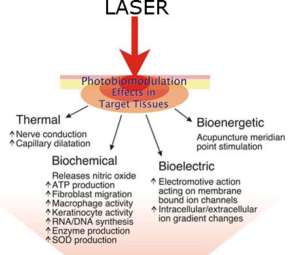
TRY INFRARED LASER THERAPY BEFORE YOU CONSIDER SURGERY FOR MANY ACUTE INJURIES
You can have the best diet and exercise program in the world, but as most of us are painfully aware, it doesn’t take much to develop an injury from an accident that you were not responsible for. Many times surgery will be recommended to repair or replace joints. There are certainly many times when surgery is appropriate and needs to be performed and we should be VERY grateful we have access to this tool, but more often than not it is inappropriately recommended because of lack of awareness of other effective options, including the healing power of lasers.
The laser is typically a tiny fraction of the cost of surgery and virtually has no side effects, unlike surgery. Class 4 laser therapy can be effectively combined with a number of other treatment modalities, including various soft tissue mobilization techniques
How is LASER DISC THERAPY different than other treatments available?
HIGH-POWER LASER THERAPY helps to reduce inflammation and increase blood circulation to help encourage the proper healing to the disc, spinal joint and nerve. This can significantly reduce or eliminate your pain and dramatically improve your quality of life!
